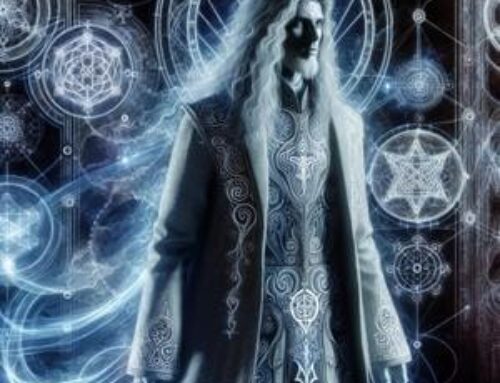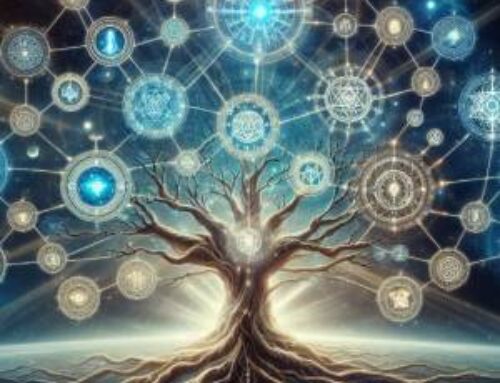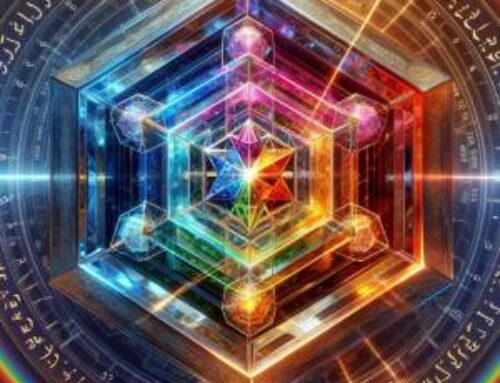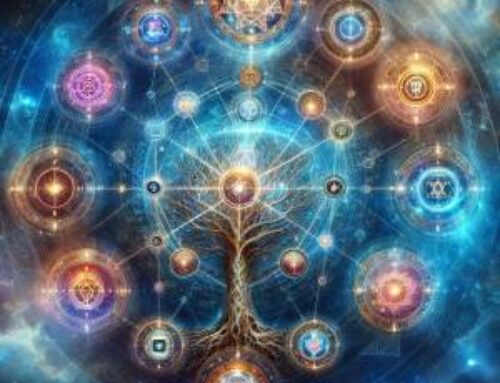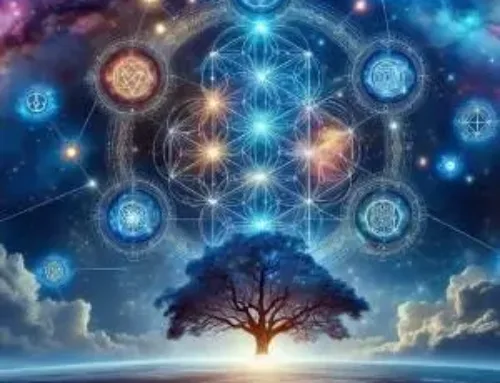Contents
- 1 Introduction to Christ Centered Kabbalah
- 2 Historical Roots and Integration
- 3 The Mystical Teachings of Jesus
- 4 The Tree of Life and the Christ Principle
- 5 The Tree of Life and the Christ Principle
- 6 Achieving Messiah Consciousness
- 7 The Role of Suffering and Redemption
- 8 Practical Kabbalah and Spiritual Practice
- 9 Conclusion
- 10 FAQ – Christ Centered Kabbalah
- 11 References:
Introduction to Christ Centered Kabbalah
In the tapestried corridors of spiritual history, where the luminous threads of mysticism weave through the fabric of religious doctrine, there lies a path seldom trodden with conscious intent—the path of Christ-centered Kabbalah. This sacred avenue, where the teachings of the Nazarene blend with the ancient wisdom of Kabbalah, invites the seeker to traverse the bounds of traditional understanding and enter a realm where divine consciousness is the final destination. Christ Centered Kabbalah offers a unique perspective on spiritual practice, merging the mystical with established Christian beliefs.
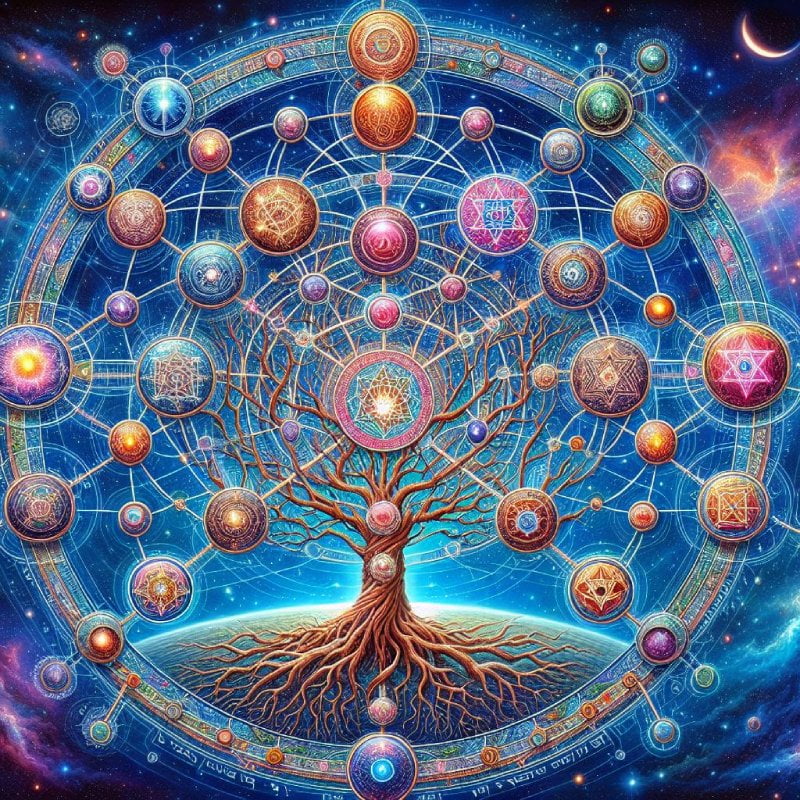
The primal tradition of the one and only revelation has been preserved under the name of Kabbalah by the priesthood of Israel (1).
Christ, a figure both historical and transcendent, emerges not merely as the central figure of Christian faith but as a bridge to the ineffable, the Kabbalistic Tree of Life itself resonating with his teachings. His words, parables, and miracles, when viewed through the Kabbalistic lens, unfold not as mere moral lessons but as profound spiritual truths, guiding the soul towards its divine origin.
Christ is wisdom, truth and love: as wisdom, He is the principle of reason, the source of the purest knowledge; as love, He is the principle of morality (2).
As we embark upon this exploration, let us shed the outer garments of preconception and, with hearts open, journey into the heart of Christ-centered Kabbalah (Hebrew: QBLH). Here, the mystic and the disciple merge, and the quest for understanding our place within the cosmos and our direct path to the Divine becomes clear. Through the prism of Kabbalah, the life and teachings of Jesus Christ are not only illuminated but are revealed as a map to the higher realms of spiritual attainment and consciousness.
Historical Roots and Integration
Individuals seeking a deeper spiritual path often find themselves drawn to the teachings of Christ Centered Kabbalah. The early Christian mystics, those souls aflame with divine love, found in the Kabbalah a mirror for the teachings they received through Christ. They perceived in Jesus not only the fulfillment of ancient prophecies but also a master of the hidden wisdom, one who spoke the language of the Kabbalah with the authority of an adept.
Kabbalah in the Time of Jesus
To understand the depth of Jesus’ teachings, one must venture into the heart of the era in which he lived—a time when Kabbalistic teachings flowed beneath the surface of Judaic religious practices. Jesus, versed in the language of the mystics, imparted his teachings in a manner that resonated with the spiritual seekers of his time, embedding the principles of Kabbalah within his parables and sermons.
Bridging Worlds
The integration of Kabbalistic wisdom into the fabric of Christian mysticism by Jesus was a monumental act of spiritual synthesis. Through his teachings, he bridged the celestial and the terrestrial, inviting his followers to see beyond the veil of the material world into the realm of divine reality.
The Legacy of Christ-centered Kabbalah
The legacy of this Christ-centered Kabbalah is a path that beckons to those seekers of truth, who, in the words of Jesus, have “ears to hear.” It is a path that offers a deeper understanding of the scriptures, not as mere texts but as living transmissions of divine light. Christ Centered Kabbalah is gaining attention among spiritual seekers who are looking to enrich their faith with ancient mystical traditions.
Kabbalah is a mystical and intellectual branch of Judaism that, since the Middle Ages, has explored the mysteries of God, sought mystical union with God, and harnessed divine energy for the betterment of the world (3).
The Mystical Teachings of Jesus
Jesus’ parables, often perceived as simple moral stories, are, in truth, cloaked teachings of Kabbalistic wisdom. Each parable, from the Prodigal Son to the Mustard Seed, serves as a key to unlocking the secrets of spiritual ascent, mirroring the journey through the spheres of the Kabbalistic Tree of Life.
The Beatitudes: A Map to Divine Attributes
The Beatitudes, delivered in the Sermon on the Mount, reflect the divine attributes of the Sephirot. “Blessed are the meek,” for instance, echoes the humility of Malkuth, while “Blessed are the pure in heart” mirrors the purity of Tipheret. Through these teachings, Jesus provided a blueprint for embodying the divine attributes on the path to spiritual enlightenment.
Miracles as Symbols of Inner Transformation
The miracles of Jesus are not merely acts of divine intervention but symbols of the potential for inner transformation within all. Turning water into wine and the multiplication of loaves and fishes signify the alchemical process of spiritual transmutation, a core principle of Kabbalistic teaching.
The Lord’s Prayer: A Kabbalistic Invocation
The Lord’s Prayer, a cornerstone of Christian devotion, parallels the structure of the Kabbalistic Tree of Life. Its petitions can be seen as invocations of the Sephirot, from Kether (“Our Father who art in heaven”) to Malkuth (“on earth as it is in heaven”), guiding the practitioner in aligning with divine will.
The Tree of Life and the Christ Principle
In the mystical architecture of the Tree of Life, the Christ Principle stands as the fulcrum, balancing mercy with severity, and grounding the highest divine emanations into tangible, earthly expressions of love and sacrifice (4). Christ’s life and teachings serve as a model for traversing the spheres, embodying the balance necessary for spiritual ascent.
The Cross: A Symbol of Cosmic Intersection
The symbol of the cross, central to Christianity, finds its esoteric counterpart in the structure of the Tree of Life. Its vertical and horizontal beams intersect at Tipheret, the Sephirah associated with beauty, sacrifice, and the solar Christ consciousness. This intersection represents the convergence of the divine with the mundane, the eternal with the temporal.
The Path of Return through Christ
The journey of the soul, as outlined in Kabbalistic teachings, mirrors the sacrificial path of Christ. Through embodying the virtues represented by the Sephiroth and following the example of Christ’s unconditional love and redemption, the seeker navigates the Tree, moving from Malkuth towards Kether, the crown of divine unity.
The Living Tree within the Heart
At the mystical heart of Christ-centered Kabbalah lies the vision of the Tree of Life as a living, breathing presence within each individual. Christ, as the living embodiment of the Tree, invites each soul to awaken to its inherent divinity, to cultivate the garden within, and to bear the fruits of spiritual wisdom and compassion.
The Tree of Life and the Christ Principle
In the mystical architecture of the Tree of Life, the Christ Principle stands as the fulcrum, balancing mercy with severity, and grounding the highest divine emanations into tangible, earthly expressions of love and sacrifice. Christ’s life and teachings serve as a model for traversing the spheres, embodying the balance necessary for spiritual ascent.
The Cross: A Symbol of Cosmic Intersection
The symbol of the cross, central to Christianity, finds its esoteric counterpart in the structure of the Tree of Life. Its vertical and horizontal beams intersect at Tipheret, the Sephirah associated with beauty, sacrifice, and the solar Christ consciousness. This intersection represents the convergence of the divine with the mundane, the eternal with the temporal.
The Path of Return through Christ
The journey of the soul, as outlined in Kabbalistic teachings, mirrors the sacrificial path of Christ. Through embodying the virtues represented by the Sephiroth and following the example of Christ’s unconditional love and redemption, the seeker navigates the Tree, moving from Malkuth towards Kether, the crown of divine unity.
The Living Tree within the Heart
At the mystical heart of Christ-centered Kabbalah lies the vision of the Tree of Life as a living, breathing presence within each individual. Christ, as the living embodiment of the Tree, invites each soul to awaken to its inherent divinity, to cultivate the garden within, and to bear the fruits of spiritual wisdom and compassion.
Achieving Messiah Consciousness
The path to Messiah Consciousness is an inward journey, traversing the inner landscapes illuminated by the teachings of Jesus and the wisdom of the Kabbalah. It is a quest not for the faint of heart but for those seekers who, driven by a profound yearning for connection with the Divine, are willing to undergo the necessary transformations.
The Role of Meditation and Prayer
Central to this journey are the practices of meditation and prayer, tools that facilitate the alignment of the individual’s will with that of the Divine. Through these practices, seekers can cultivate a state of heart and mind that resonates with the frequencies of Messiah Consciousness, gradually dissolving the barriers that separate them from this sublime state of being.
Embodying the Virtues
Achieving Messiah Consciousness also involves the embodiment of the virtues represented on the Kabbalistic Tree of Life. From the foundation of humility in Malkuth to the pinnacle of divine unity in Kether, each Sephirah offers specific lessons and challenges designed to refine the soul’s qualities, aligning them with the attributes of the Messiah.
The Transformative Power of Love
At the core of Messiah Consciousness is the transformative power of unconditional love—a force that transcends personal desires and attachments, reaching out to touch the hearts of all beings. This love, as demonstrated by Jesus, has the power to heal, to forgive, and to awaken the dormant divinity within each person, catalyzing a profound shift in consciousness.
The Role of Suffering and Redemption
The trials and tribulations faced by individuals are not mere obstacles but are, instead, sacred opportunities for awakening. Just as Jesus endured suffering and emerged as a beacon of divine love and forgiveness, so too can the modern seeker utilize their personal trials as gateways to higher consciousness and understanding.
The Crucible of Transformation
Suffering serves as a crucible, within which the base metals of the human condition are transmuted into the gold of spiritual enlightenment. This alchemical process, deeply embedded in Kabbalistic teachings, mirrors Jesus’ journey from crucifixion to resurrection, symbolizing the soul’s passage from darkness into light.
Redemption Through Love and Forgiveness
Central to the path of redemption within Christ-centered Kabbalah is the practice of unconditional love and forgiveness. These powerful acts, exemplified by Jesus, have the potential to not only alleviate personal suffering but also to heal the wounds of humanity, paving the way for collective redemption and the realization of Messiah Consciousness.
Practical Kabbalah and Spiritual Practice
Christ-centered Kabbalah emphasizes the importance of living out the virtues represented by the Sephiroth on the Tree of Life. This involves embodying qualities such as loving-kindness, strength, beauty, and wisdom in everyday actions and interactions, striving to manifest the balance and harmony of the Sephirot in the physical world. Christ Centered Kabbalah extends an invitation to explore a spiritual journey that is both reflective and profound.
Acts of Loving Service
Following the example set by Jesus, acts of loving service are central to practical Kabbalah. This service is seen as an expression of divine love, where helping others and contributing to the betterment of the world are ways of aligning with the Will of the Divine, fostering a sense of unity and interconnectedness.
The Rituals of Connection
Practical Kabbalah incorporates rituals that serve to connect the practitioner more deeply with the divine energies of the Tree of Life. These rituals, which can include candle lighting, prayers, and the creation of sacred spaces, are designed to sanctify daily life, making the mundane sacred and the sacred tangible. Incorporating elements of Christ Centered Kabbalah into one’s spiritual routine can lead to a more contemplative and enriched faith experience.
Conclusion
In the journey through the realms of Christ-centered Kabbalah, we have traversed the landscapes of history, delved into the mystical depths of Jesus’ teachings, and applied the timeless wisdom of the Kabbalah to our daily lives. This exploration has revealed a pathway not merely of belief but of deep, transformative experience—a path that leads to the heart of divine mystery.
Christ-centered Kabbalah extends an invitation to each soul: to awaken from the slumber of material existence and to embark on a quest for spiritual truth. It offers not only a map for this journey but also the living example of Jesus Christ as the embodiment of divine love, wisdom, and power.
The teachings of Christ-centered Kabbalah hold the promise of achieving Messiah Consciousness—a state of being that transcends individual limitations and opens the heart to the unity of all creation. This enlightened state, mirrored in the life and teachings of Jesus, is accessible to all who earnestly seek to align their lives with divine will and purpose.
An Invitation to Further Exploration
In the vast expanse of spiritual inquiry, where the soul’s thirst for understanding beckons it towards the light of wisdom, the Hermetic Academy stands as a guiding star. It is here, within this fellowship of the earnest seeker, that the mysteries of Christ-centered Kabbalah unfold, offering paths paved with the insights of ages and the promise of personal transformation.
FAQ – Christ Centered Kabbalah
1. What is Christ Centered Kabbalah?
Christ Centered Kabbalah weaves together the teachings of the Nazarene with the esoteric wisdom of the Kabbalah, focusing on illumination of the spirit and the mystical passage through the Tree of Life towards the consciousness of the Divine.
2. How does it reinterpret Jesus’ teachings?
It perceives the parables and instructions of Jesus as profound, esoteric revelations, in harmony with Kabbalistic doctrines, offering a conduit to comprehend the attributes of the Divine and the soul’s elevation.
3. What role does the Tree of Life play?
The Tree of Life serves as the map for the soul’s passage to unity with the Divine, with the Christ Principle as the beacon guiding the harmonization and integration of divine forces within the mystical passage.
4. Can anyone attain Messiah Consciousness?
Indeed, Messiah Consciousness is open to all, as it reflects the quintessence of our elevated essence. Through steadfast spiritual disciplines and harmonization with divine laws, individuals may reach this pinnacle of awakened awareness.
References:
(1) Eliphas Levi. (1854). Dogme et Rituel de la Haute Magie. Paris, Frankreich.
(2) Eckartshausen, Karl von. (1802). Die Wolke über dem Heiligtum. München, Germany.
(3) Tirosh-Samuelson, H. (2013). Kabbalah in Judaism. . https://doi.org/10.1007/978-1-4020-8265-8_1519.
(4) Rubenstein, E. (2020). The Tree of Life: The Kabbalah of Immortality. Hermetic World, Paphos.

